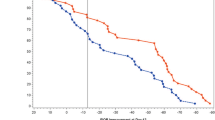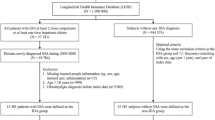Abstract
The aim of the study was to assess iron serum levels and markers of iron stores in non-anemic fibromyalgia (FM) patients and to evaluate their impact on the prevalence and clinical manifestations of FM patients. Eighty-four patients with primary FM and 87 controls were investigated. Demographic and clinical data were collected from all participants. All patients completed the fibromyalgia impact questionnaire (FIQ). Patients evaluated the effect of the disease on their daily activity (DA) and judged the severity (DS) of the disease on a 0–10 scale. Venous blood was tested for serum iron, transferrin, ferritin, and soluble transferrin receptors (sTfR). Iron deficiency was defined if any of the following were present: serum iron <40 μg/dL, serum ferritin levels <10 ng/mL, or sTfR levels >28.1 nmol/L. Analysis at a cutoff level of serum ferritin levels ≤30 ng/mL and sTfR/ferritin ratio was also performed. Hemoglobin, iron, transferrin, sTfR, ferritin levels, and sTfR/ferritin ratios did not differ between the groups. The mean FIQ score was 57.13 ± 20.21 and the DA and DS scores were 6.79 ± 2.97 and 6.74 ± 3.09, respectively. No correlations were found between the parameters studied and the FIQ or its ten individual items. Thirty-eight controls (43.7%) and 23 FM patients (27.4%) had ferritin levels of ≤30 (p < 0.04). Within the FM group, lower levels were associated with lower total FIQ score and FIQ subscale scores. Patients with FM do not have reduced serum levels of iron or surrogate markers of iron stores. At present, there is no evidence to support iron supplementation in the treatment of FM.

Similar content being viewed by others
References
Wolfe F, Smythe HA, Yunus MB, Bennett RM, Bombardier C, Goldenberg DL, Tugwell P, Campbell SM, Abeles M, Clark P et al (1990) The American College of Rheumatology 1990 Criteria for the Classification of Fibromyalgia. Report of the Multicenter Criteria Committee. Arthritis Rheum 33:160–172
Branco JC, Bannwarth B, Failde I, Carbonell JA, Blotman F, Spaeth M, Saraiva F, Nacci F, Thomas E, Caubère JP, Le Lay K, Taieb C, Matucci-Cerinic M (2010) Prevalence of fibromyalgia: a survey in five European countries. Semin Arthritis Rheum 39:448–453
Mease PJ, Arnold LM, Crofford LJ, Williams DA, Russel IJ, Humphrey L, Abetz L, Martin SA (2008) Identifying the clinical domains of fibromyalgia: contributions from clinician and patient Delphi exercises. Arthritis Rheum 59:952–960
Pamuk GE, On P, Set T, Harmandar O, Yesil N (2008) An increased prevalence of fibromyalgia in iron deficiency and thalassemia minor and associated factors. Clin Rheumatol 27:1103–1108
Looker AC, Dallman PR, Carroll MD, Gunter EW, Johnson CL (1997) Prevalence of iron deficiency in the United States. JAMA 277:973–976
Patterson AJ, Brown WJ, Roberts DCK (2001) Dietary and supplement treatment of iron deficiency results in improvements in general health and fatigue in Austrian women of childbearing age. J Am Coll Nutr 20:337–342
Murray-Kolb LE, Beard JL (2007) Iron treatment normalizes cognitive functioning in young women. Am J Clin Nutr 85:778–787
Agarwal R (2007) Nonhematological benefits of iron. Am J Nephrol 27:565–571
Ortancil O, Sanli A, Eryuksel R, Basaran A, Ankarali H (2010) Association between serum ferritin level and fibromyalgia syndrome. Eur J Clin Nutr 64:308–312
Buskila D, Neumann L (1996) Assessing functional disability and health status of women with fibromyalgia: validation of a Hebrew version of the fibromyalgia impact questionnaire. J Rheumatol 23:903–906
Mast AE, Blinder MA, Gronowski AM, Chumley C, Scott MG (1998) Clinical utility of the soluble transferrin receptor and comparison with serum ferritin in several populations. Clin Chem 44:45–51
Punnonen K, Irjala K, Rajamaki A (1997) Serum transferrin receptor and its ratio to serum ferritin in the diagnosis of iron deficiency. Blood 89:1052–1057
Mease P, Arnold LM, Bennett R, Boonen A, Buskila D, Carville S et al (2007) Fibromyalgia syndrome. J Rheumatol 34:1415–1425
Mease P (2005) Fibromyalgia syndrome: review of clinical presentation, pathogenesis, outcome measures, and treatment. J Rheumatol Suppl 75:6–21
Mease P, Arnold LM, Choy EH, Clauw DJ, Crofford L, Glass JM, OMERACT Fibromyalgia Working Group et al (2009) Fibromyalgia syndrome module at OMERACT 9: domain construct. J Rheumatol 36:2318–2329
Hudson JI, Arnold LM, Bradley LA, Choy EH, Mease PJ, Wang F et al (2009) What makes patients with fibromyalgia feel better? Correlations between Patient Global Impression of Improvement and changes in clinical symptoms and function: a pooled analysis of 4 randomized placebo-controlled trials of duloxetine. J Rheumatol 36:2517–2522
Beard JL, Connor JR, Jones BC (1993) Iron in the brain. Nutr Rev 51:157–170
Beard JL, Connor JR (2003) Iron status and neural functioning. Annu Rev Nutr 23:41–58
Ortiz E, Pasquini JM, Thompson K, Felt B, Butkus G, Beard J, Connor JR (2004) Effect of manipulation of iron storage, transport, or availability on myelin composition and brain iron content in three different animal models. J Neurosci Res 75:681–689
McCann JC, Ames BN (2007) An overview of evidence for a causal relation between iron deficiency during development and deficits in cognitive or behavioral function. Am J Clin Nutr 85:931–945
Dowling P, Klinker F, Amaya F, Paulus W, Liebetanz D (2009) Iron deficiency sensitizes mice to acute pain stimuli and formalin induced nociception. J Nutr 139:2087–2092
Verdon F, Burnand B, Fallab Stubi CL, Bonard C, Graff M, Michaud A et al (2003) Iron supplementation for unexplained fatigue in non-anaemic women: double blind randomised placebo controlled trial. BMJ 326:1124
Sun ER, Chen CA, Ho G, Earley CJ, Allen RP (1998) Iron and the restless legs syndrome. Sleep 21:371–377
Disclosures
None.
Author information
Authors and Affiliations
Corresponding author
Rights and permissions
About this article
Cite this article
Mader, R., Koton, Y., Buskila, D. et al. Serum iron and iron stores in non-anemic patients with fibromyalgia. Clin Rheumatol 31, 595–599 (2012). https://doi.org/10.1007/s10067-011-1888-x
Received:
Revised:
Accepted:
Published:
Issue Date:
DOI: https://doi.org/10.1007/s10067-011-1888-x




